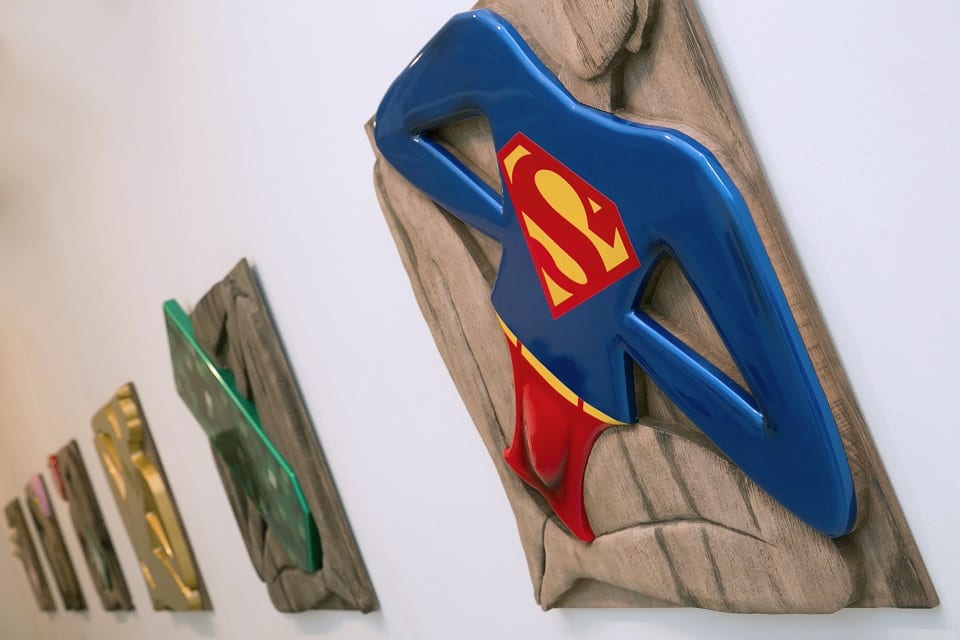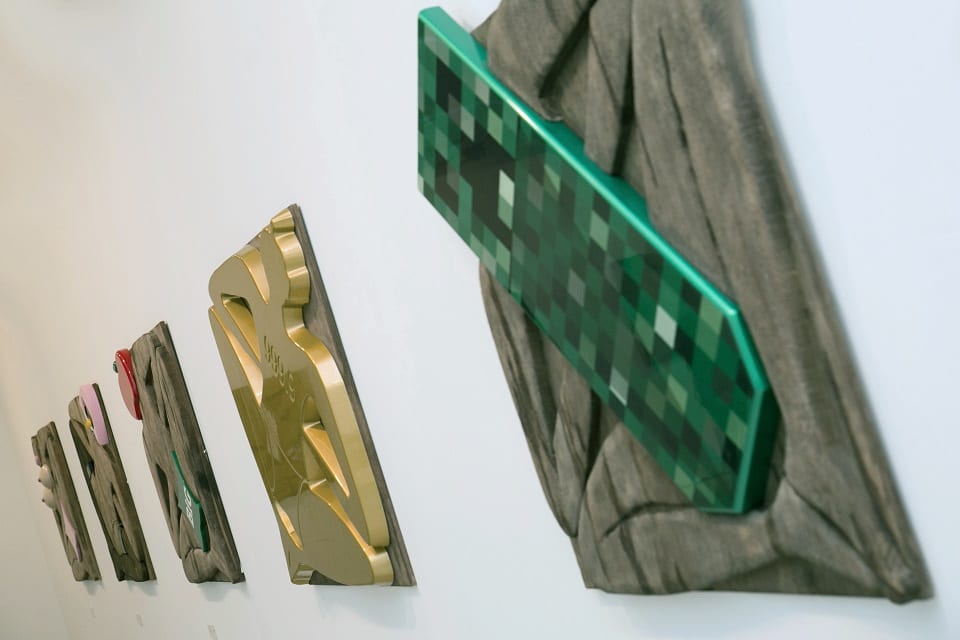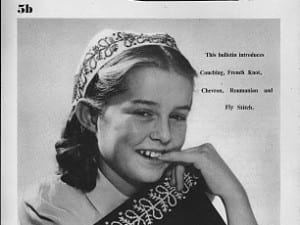Examining the balance between tradition and new trends, Olga Lomaka’s Artefacts combines elements of surrealism and pop art. Unexpected techniques create vibrant and complicated pieces, whether through painting, sculpture or installation.
A: Your Artefacts series includes a number of Buddha images carved on wooden panels, incorporating westernised images from social media and networking sites. How do the images coalesce in your mind in terms of values, culture, social understanding and, in some cases, rituals?
OL: Artefacts are simple and, at the same time, complex. The image of the Buddha is the moral axis of the project, and is certainly central to its development. His bas-relief, sculpted form embodies timeless notions about the perception of the world and the self.
A couple of years ago, when I was on Bali island, the thought occurred to me that Buddha embraces a wide range of values, from any nationality or language, without prejudice or favoritism. It is universally acknowledged artefact of Eastern culture that spans centuries, and retains an influence on the collective consciousness of today’s society.
I wondered if in today’s world, the new social phenomena and advanced technologies brought up by western culture could become such artefacts a few centuries later. So, I began focusing on the symbols of consumer society that are, to my mind, in strongest contrast to the image of Buddha. The project reveals my reflections on the co-existence of values old and new, and how they shape our mindset. Some prefer the modern over the ancient, and some do the exact opposite. I have made my choice, and it is obvious throughout the project.
A: Combining eastern and western cultures, the series opens up dialogues between inter-continental similarities and differences. Do you think this is important in an age where the world is in such a state of flux?
OL: Yes, I believe that nowadays it is indeed of highest value. This phenomenon of intercultural relations and is exactly what has inspired my art. Differences shouldn’t become our common ground; they don’t hinder the progress, they are the way to find a better solution for a life in harmony. The contemporary climate is one of controversy – mutual understanding is the only viable means to overcome crises internationally.
In Artefacts, Buddha accepts the new attributes of life that belong to the young generation; they suddenly become part of him. Often, the two contrasting subject matters don’t go together smoothly, and sometimes they do, but the most important word here is together. The core idea of this project is not only evolution of traditional values in the world of new trends; it is also about accepting the changes that are growing or already blossoming in the modern society. Understanding those changes will probably facilitate the global dialogue between cultures and individuals. I am trying to bring east and west as close to each other as it is possible under the given circumstances without losing each of their identities.
May it be that a person who lives by the traditional religion will wear a Rolex timepiece? Why not? I think these questions are crucial to the development of our international society. It is time for us to set aside stigmas and stereotypes, and to stop sacrificing some things for the sake of the others. It all comes down to the state of harmony in one’s consciousness, and only in this state can we understand each other. Art is one of the universal languages that will help us all reach this kind of understanding.
A: Do you feel a sense of responsibility to make statements during this time of change as an artist?
OL: Society is oversaturated with social networks, fashion industries, technologies and entertainment culture – all new developments that are progressing at an explosive rate. Even I find it difficult keeping a sense of direction in this overflow of information. Nevertheless, I am aware of what I want to highlight and demonstrate before the viewer. My art is not always constructive; on some occasions, I use provocative imagery to put an emphasis on the sense of the artwork. As of now, I am fond of sculpture and installation because I feel that these forms of art have stronger potential of impressing the viewer.
My ideal scenario is that my exhibitions serve not only to please someone’s sense of beauty, but also to spark someone’s thoughts about being, delving into their psyche and thinking more widely about cultural and social phenomena. Thus, I do indeed feel that I am responsible for my work as it influences those that come in contact with it. This is every artist’s unique opportunity.
A: Your newest project, Pink Magic, includes a series of sculptural installations and will be exhibited this year. Could you talk about the concept for the works and where they will be displayed?
OL: Last year, I decided to concentrate more on sculpture and installation. I got interested in how to reveal the full potential of space in artwork – how it changes and interacts with other components – and how it plays visual tricks with the viewer’s mind. These ideas come forward in Pink Magic, which is a series of multi-coloured constructions. Do you know why I am so fond of pop-art? Working in this style, I can communicate complex thoughts with simple, well-known images and humour. In fact, pop-art doesn’t oblige you to draw any conclusions, but if you so wish, you can dig deeper and unearth a vast world filled with complex allegories and interpretable symbols. My new project is a research of interrelations between the masculine and feminine. The main protagonist is taken from the opening scenes of the Pink Panther movie. I adore him because I see so many different sides to him.
Firstly, it is an animal with unusually coloured coat, who behaves in an incredibly individual way. Secondly, it is a rare diamond that is an object of everyone’s desire. The panther embodies the male principle. Unlike the other important element of the project, he is able to act. At the same time, the cut in the opening scene is always static, and it is in the centre of the screen. It is the beginning and it is the end. This is the female principle. When these elements merge and interact, you get Pink Magic, or infinity.
The first exhibition is to take place in London this summer. Then I will bring the exposition to Moscow and Kiev. I am ready to push the boundaries even further, so I also intend to display the project in Paris, Hong Kong, Tokyo and New York.
www.olgalomaka.com
www.instagram.com/lomakaart
Credits:
1. Olga Lomaka, Artefacts, Installation View at Saatchi Gallery, London. Courtesy of the artist.





